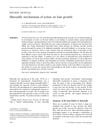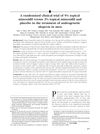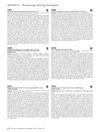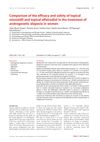TLDR The essence made from fermented products increased hair growth in mice better than minoxidil.
In the 2012 study, researchers found that an essence made from products fermented by Lactobacillus rhamnosus and backryeoncho fruits promoted hair growth in male C57BL/6 mice more effectively than minoxidil. The essence was applied topically at 0.1 mL daily for 8 days, resulting in significant hair growth without adverse effects on body weight or food intake. Histological analysis showed that the essence increased the depth and size of hair follicles more than minoxidil. The study concluded that the fermented product essence has a potent hair growth promoting effect, warranting further research for practical use.
 397 citations
,
February 2004 in “British Journal of Dermatology”
397 citations
,
February 2004 in “British Journal of Dermatology” Minoxidil boosts hair growth by opening potassium channels and increasing cell activity.
 269 citations
,
August 2002 in “Journal of The American Academy of Dermatology”
269 citations
,
August 2002 in “Journal of The American Academy of Dermatology” 5% minoxidil works better for hair growth and density, with minor irritation.
28 citations
,
January 1996 in “Skin Pharmacology and Physiology” Minoxidil boosts hair cell growth, while cyclosporin does not.
23 citations
,
September 1992 in “Archives of Dermatological Research” Cepharanthine and minoxidil promote cell growth and delay hair cell maturation.
January 2022 in “Wiadomości lekarskie (Warsaw Poland)” MSM reduces hair loss and promotes hair growth in male mice.
February 2020 in “The Pharmaceutical Society of Japan”  April 2018 in “Journal of Investigative Dermatology”
April 2018 in “Journal of Investigative Dermatology” Minoxidil didn't significantly increase hair growth in minipigs.
 56 citations
,
April 2007 in “Journal der Deutschen Dermatologischen Gesellschaft”
56 citations
,
April 2007 in “Journal der Deutschen Dermatologischen Gesellschaft” Minoxidil works better for female hair loss than alfatradiol, both safe.
January 2007 in “Strait Pharmaceutical Journal” Water-soluble minoxidil effectively promoted hair growth in mice.
 1 citations
,
September 2002 in “PubMed”
1 citations
,
September 2002 in “PubMed” Minoxidil helps stimulate hair growth and reduce hair loss in women with androgenic alopecia.





